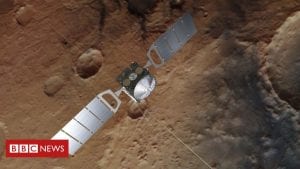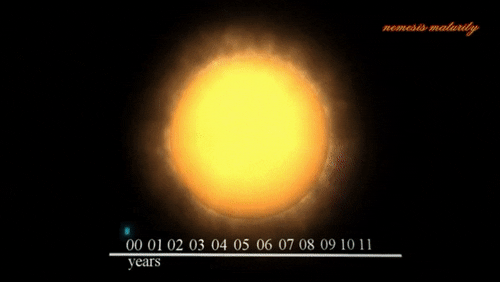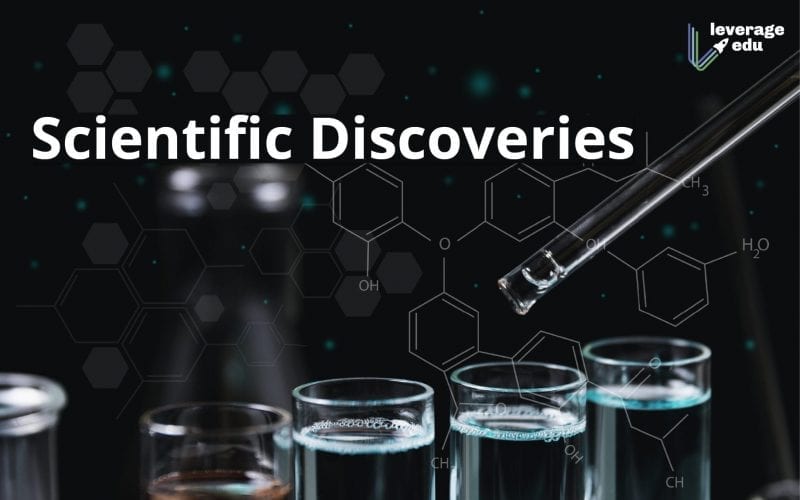The year 2020 has been extremely reproached by everyone around the world. The year has been a bane and boon in various sectors. With the world still finding its way around the lockdowns, the end of the decade is still yet to feel like the beginning of the new amazing one! This amazing side of 2020 includes the academic and research milestones we have set. There were major scientific discoveries made which tapped COVID-19 and many more domains. Scroll through this blog to know the best scientific discoveries, inventions, and observations made this year.
Buried Lakes Discovered On Mars

The first scientific discovery on our list has raised the possibility of finding life on the red planet. 2 years ago, Astronomers reportedly discovered a large lake beneath a thick layer towards Mars’ south pole. However, the finding has been confirmed by scientists in 2020 when they detected 3 underground lakes in the same area. Amongst the scientific discoveries of 2020, these studies suggest that there might exist more lakes underground on Mars. Hypersaline water indicates the presence of marine life in the water bodies. Researchers believe that the underground water could be millions or billions of years old when Mars was warmer and moist like the Earth. For conducting the phenomenal discovery, the researchers used a study based on 134 observations conducted between 2012-2019. Scientists had used radar instruments to send radio waves into Mars’ surface that reflect differently depending on the material present underground. This method is also used to find subglacial lakes on Earth. Higher reflectivity signals large water bodies present under the surface. Future missions on the red planet should focus on this region for increasing the possible living on Mars in the future!
Into the Solar Cycle 25

Since the 18th century, scientists have been recording the cycles and there have been 24 cycles observed. Our bright star, the sun entered its 25th solar cycle in December 2019. The electrically charged ball of hot gas moves and generates a powerful magnetic field that goes through a cycle, called the solar cycle. Every 11 years or so, the north pole and the south pole of the magnetic fields switch places. This flip results in a new cycle every 11 years. The last recorded cycle began in 2008 and ended in 2019. The scientists track these cycles using sunspots/ dark spots which are associated with solar activities. Amongst the top observations and scientific discoveries of 2020, the solar cycles have a huge impact on the Earth from radio-communications, solar grids, and increases in radiation on Earth to astronauts who travel and work in space.
Zeptosecond, a New Unit of Time

For the first time, atomic physicists measured the smallest unit of time called the Zeptosecond, which is a trillionth of a billionth of a second. Another key mention in our list of scientific discoveries of 2020, scientists found this unit by measuring the time taken for a photon to cross a hydrogen molecule. They performed the time measurement on a hydrogen molecule after which they exposed it to the X-radiations from a synchrotron light source. They set the energy of the X- radiations in such a manner that one photon would be sufficient to eject both electrons out of the hydrogen molecules. During the process, scientists measured the interference pattern of the first ejected electron and regulated the positioning of the hydrogen molecule (H2). They then determined the spatial orientation of the molecule and used the interference of 2 electron waves to calculate the time when the photon reached the first and second hydrogen atoms. The 2 steps are calculated to be 247 zeptoseconds depending on the distance between the two atoms. This huge scientific discovery is the shortest time span that has been successfully measured to date, after the last recorded time- femtoseconds.
Synchrotron: A large machine (almost the size of a football field) that accelerates electrons to almost the speed of light. As the electrons are deflected through magnetic fields they create extremely bright light which is channelled down beamlines to experimental workstations used for research.
A Super Enzyme that Eats Plastic 6 Times Faster

A much-needed breakthrough in the world, scientists have engineered an enzyme that can eat plastic bottles 6 times faster. This is also one of the top scientific discoveries of 2020 as scientists have created the super-enzyme by linking two separate enzymes. Which were naturally found in plastic-eating bugs. These plastic-eating bugs were first discovered in Japan in 2016 that used to start breaking down plastic in very few days. But scientists observed that 2 enzymes joined together can increase this speed and can be effective even at room temperature. Plastic use is one of the rooted issues in our environment and this could enable 100% of recycling of plastic in the world. By combining various approaches, scientists can speed up this process for commercial use in a few years.
Discovery of the ‘Trojan Horse’ Nanoparticle

Another major scientific discovery in the field of biology is the invention of a nanoparticle that eats portions of plaques that are responsible for heart attacks. The breakthrough can be a potential treatment for Atherosclerosis which is a major cause of death globally. The nanoparticles target the atherosclerotic plaque which is highly sensitive to a particular immunity which are monocytes and macrophages. Once the nanoparticles reach inside the macrophages, it delivers a drug agent that stimulates the cell to engulf and eat cellular debris which extracts the dead cell in the plaque’s core. The macrophages can be revitalized which reduces the plaque size, making it stabilized. Future research on nanoparticles can lead to reduced risks of most of the types of heart attacks and the treatments can have minimal side effects. The previous study had only acted on the surface of the cells but the current study works intracellularly. The stimulation of the macrophages is a crucial breakthrough in this approach to selectively eat dead or dying cells. The inflammatory cells are the precursor cells to this disease which are a major cause of heart attacks. The novel study can also be applied beyond Atherosclerosis.
Our Dreams Are a Continuation of Reality
Researchers analyzed 24,000 dreams and confirmed the “continuity hypothesis” theory which is a massive discovery for scientists and psychologists A team of researchers developed an automated tool to extract data from dreams and analyzed the content of the dream. For, a long, many theories have tried to explain where dreams come from or how they are formed. From Nolan’s world of inception to the psychological world, many theorists have labelled and portrayed dreams differently or as a spiritual world that is unknown to reality. This is also one of the unique scientific discoveries of 2020 as we are continuously looking for meaningful connections that link the content of our dreams to our daily lives.
The theory “continuity hypothesis of dreams” indicates that dreams are a continuation of the events that take place in our lives. If you are anxious throughout the day, you might experience nightmares in your dreams. Much of the study is influenced by the psychoanalytical world of Sigmund Freud. He stated that dreams subconsciously feed into our brains and are a disguised fulfilment of a repressed wish. He also mentioned that dreams have hidden meaning and are a royal road to the unconscious. The dreams could reveal the underlined meaning of a person’s daily interactions. Therapists often help people interpret their dreams by understanding patterns and drawing connections. Scientists have now discovered an automated way to analyze dreams by tracking people’s dreams on a large scale. They designed a tool that automatically scores the dreams reports based on the ‘Hall and Van de Castle”. The researchers found that their tools match the experts’ reports and found evidence to support their data. This massive study can help create a bridge between reality and dreams.
Fastest Internet Speed Ever
As the internet transforms and connects our lives with people globally, this technology of the internet keeps getting better. Scientists set a new record for the fastest internet speed ever. It can reach an incredible speed of 178 terabits/second. It is double the speed of the internet available today and can allow us to download the entire Netflix collection/ a 4K movie in just a single second! It is the fifth fastest than the previous record which was set by a team in Japan. The internet is built on optical fibre routes that have amplifiers. Scientists plan to add the new technology to the existing amplifiers placed around 25-62 miles apart. Scientists said that this new achievement can result in more than a super-lab experiment and the technology can be added to the optic fibre routes. One of the top Scientific discoveries of 2020, this ground-breaking record can also be applicable to future transportation and communication.
Artificial Skin that Reacts to Pain

Scientists developed artificial skin that reacts to pain and temperature just like our real skin. It is a huge discovery that paves the way for better prosthetics and robotics. It also provides alternatives for non-invasive alternatives to skin grafting. The skin is the largest sensory organ in our body. It has complex features and instant warning signals activated whenever anything hurts us. Most of our daily sensations are felt through the skin itself, but the pain response only kicks in at a certain threshold. This reflex works when we touch something too sharp or hot. For this revolutionary scientific discovery by RMIT University, the three main prototypes developed were “stretchable electronics”, “temperature-reactive coating”, and brain “mimicking memory”. The device electronically replicates the way our skin senses pain. It has the mechanism to mimic the body’s near-instant feedback response and react to pain which is obtained with the same high speed that nerve signals use to travel to the brain. To date, no electronic technology has been able to realistically copy the feeling of pain or tell the distinction between different intensities of pain. The device knows the exact difference between a gentle pin touch or stabbing yourself with a pin! It can not only sense pain but also perceive and react to changes in temperature and pressure. These electronic some-sensors were a major leap towards future biomedical technologies.
World’s First Device To Restore Vision of The Blind
Scientists begin clinical trials for the revolutionary device that can restore vision to the blind. This scientific discovery is the first of its kind and a vital invention in the world. Currently, the device is being prepared for clinical trials in Australia. Amongst the best scientific discoveries for the visually impaired, researchers have developed miniaturized, wireless electronic implants that perch on the surface of the brain and have the capacity to restore vision. Many people who are clinically blind have damaged optic nerves that prevent signals from being transmitted from the retina to the vision centre of the brain. The bionic vision system can bypass the damage to the optic nerves. The system consists of headgear with a camera, wireless transmitter, and a vision processor unit. The mini tiles are implanted into the brain. The event captured by the video camera in the headgear will be sent to the vision processor where it can extract the most useful information. Then the data will be transmitted wirelessly to the implanted tiles. The data is then converted into a visual pattern of electrical pulses which stimulates the brain. The visual patterns navigate indoor and outdoor environments and allow individuals to recognize the objects and people around them. The pioneering technology could also deliver improved health outcomes for patients with untreatable neurological conditions like limb paralysis, epilepsy, and depression.
First Functioning Mini Heart Model

The first functioning mini-human heart model is also one of the greatest scientific discoveries of 2020. The heart model created by Michigan State University researchers includes all the primary heart cell types and a functioning structure of chambers and vascular tissue. Scrutinizing fetal heart development faults requires access to a developing human heart with similar features. The previous research in this field has been limited to the use of models of mammals by donated embryonic remnants which raised ethical questions. This mini-heart model can be useful to study all types of cardiovascular disorders and heart diseases without violating principles. This can also be precisely used with a unique level of accuracy. Heart diseases are the major cause of death and this technology involves a bioengineering procedure that can be efficiently used. The heart organoids were created using a new stem cell framework and within that embryonic and fetal developmental environments are replicated. Scientists are currently using the heart organoids to model congenital heart disease which is the most frequent birth flaw in the newborn population.
Fish Fins Are as Sensitive as Fingertips
University of Chicago neuroscientist Adam Hardy and his lab discovered this year that fish fins aren’t just for steering and swimming. In reality, fins are as sensitive as primate fingertips, the researchers found. The researchers studied round gobies, a type of bottom-dwelling fish native to places like the Black Sea and the Caspian Sea, to draw this conclusion. To establish how sensitive the fins of the gobies were, the team injected euthanized fish with a saline solution that during their experiment kept their nerves functioning normally. When the fish’s fins rubbed up against a ridged wheel, they then used a special device to record the patterns of electrical impulses generated by the nerves.
Extinct Cave Bear Found in the Siberian Permafrost

In northern Russia, on Great Lyakhovsky Island between the Laptev Sea and the East Siberian Sea, a carcass of an Ice Age cave bear was discovered. With its nose, teeth, and internal organs still intact, the adult cave bear carcass was found perfectly preserved on a remote Siberian island. In a September press release, Lena Grigorieva, a researcher at the North-Eastern Federal University in Yakutsk, Russia, said, “This is the first and only find of its kind — a whole bear carcass with soft tissues,” Scientists think that 22,000 to 39,500 years ago, the cave bear died. During the last Ice Age, his genus, Ursus spelaeus, lived and went extinct 15,000 years ago.
Archaeologists in England Identified Origin of Boulders Used in Stonehenge

Stonehenge, which is estimated to be about 5,000 years old, consists of two distinct kinds of half-circled stone slabs. Researchers traced one type, the smaller bluestones, 150 miles away to a site in Wales. The 30-foot (9-meter) sandstone boulders, named sarsens, which make up the rest of the monument came from a nearby forest area, as per the research from July suggests. Still, the builders of Stonehenge had to drag about 15 miles of the 50,000-pound (22,700-kilogram) sarsens, “which is insane really if you think about it,” said Business Insider earlier, archaeologist David Nash, the lead author of the report.
FAQs
The smallest unit of time is called the Zeptosecond, which is a trillionth of a billionth of a second.
This artificial skin was developed by RMIT University.
Currently, the Stonehenge weighs around 22,700 kg.
These were 10 revolutionary scientific discoveries that brought a silver lining to the new normal year of 2020. Want to pursue a career in research? Get in touch with our Leverage Edu experts and we will help you explore the top research-oriented courses and universities in the world! Sign up for a free session with us today!

 One app for all your study abroad needs
One app for all your study abroad needs






















 45,000+ students trusted us with their dreams. Take the first step today!
45,000+ students trusted us with their dreams. Take the first step today!


